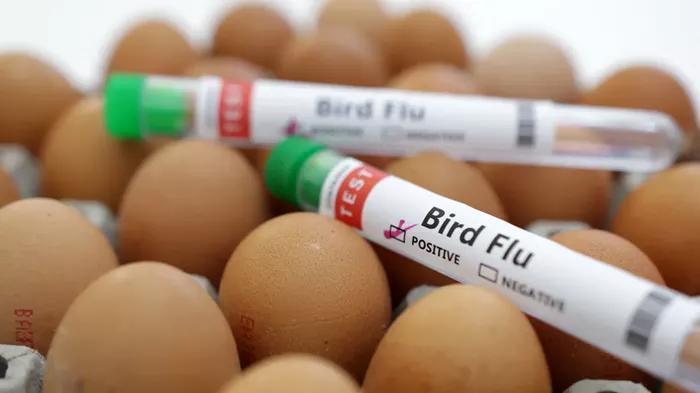California’s dairy industry is grappling with an unprecedented crisis as a devastating bird flu outbreak spreads through the state’s dairy herds. Over the past few months, more than 120 herds have been affected, leading to significant cattle deaths and the alarming sight of carcasses left rotting in the scorching heat. The situation is exacerbated by an overwhelmed rendering industry struggling to process the large number of deceased animals.
The bird flu virus has impacted over 300 dairy herds across 14 states this year, but California’s dairy sector has seen particularly severe consequences. Mortality rates for infected herds in California have soared to as high as 15% to 20%, a staggering contrast to the 2% seen in other states, according to veterinary expert Keith Poulsen.
In California’s Central Valley, where dairy farms are clustered, extreme heat has worsened the health of already-ailing cows, leading to fever, reduced milk production, and death. Anja Raudabaugh, CEO of Western United Dairies, which represents nearly 90% of the state’s dairy farmers, reported that farms normally losing one or two cows per month are now losing hundreds due to the virus and the blistering temperatures.
The soaring temperatures—exceeding 95°F (35°C) multiple times in October—have further strained rendering companies responsible for disposing of the dead animals. With these companies unable to keep up, some carcasses have been left exposed to the elements, raising concerns about the spread of the virus to wild birds and other animals.
“Baker Commodities, a key rendering company, has seen a sharp rise in the number of dead dairy cows due to both the heat and the bird flu,” said spokesperson Jimmy Andreoli II. “While we’ve experienced some delays, particularly due to safety measures such as disinfecting truck tires to prevent the spread of the virus, we are working hard to keep up with the demand.”
However, not all farmers are finding relief. In some cases, animals have been left outdoors for days as rendering plants struggle to keep pace, causing health and biosecurity risks. Infected cows are often left far from healthy herds to mitigate further virus transmission, but the mounting number of carcasses continues to be a challenge.
Veterinarian Crystal Heath, based in Los Angeles, expressed concern over the lack of widespread testing in the state to contain the virus. She shared photos of dead cows left outside Mendonsa Dairy in Tulare County, highlighting the urgent need for improved containment measures. “The state needs to step up its testing efforts to control the spread of this virus,” she said.
Farmers like Joey Airoso, a Tulare County dairy operator, have become increasingly concerned as nearby dairies continue to be hit by the virus. “The way it’s been spreading around here, I feel like almost every farm is going to get it,” he remarked.
The bird flu crisis in California’s dairy farms is not only devastating animal health but also impacting the livelihoods of thousands of dairy workers and farmers. The ongoing struggle to manage both the outbreak and the extreme heat serves as a stark reminder of the challenges faced by the state’s vital dairy industry.
As experts continue to investigate the origins of the outbreak and its spread, California’s dairy community remains on high alert, seeking both immediate and long-term solutions to combat the bird flu and protect the health of their herds.
Read More:
Merck’s Clesrovimab Proves 60% Effective In Preventing RSV Infections In Infants
New Insights Into Human Evolution: Starch-Digesting Genes Date Back 800,000 Years
New Pediatric Heart Stent Offers Lifelong Benefits For Children With Congenital Heart Defe


